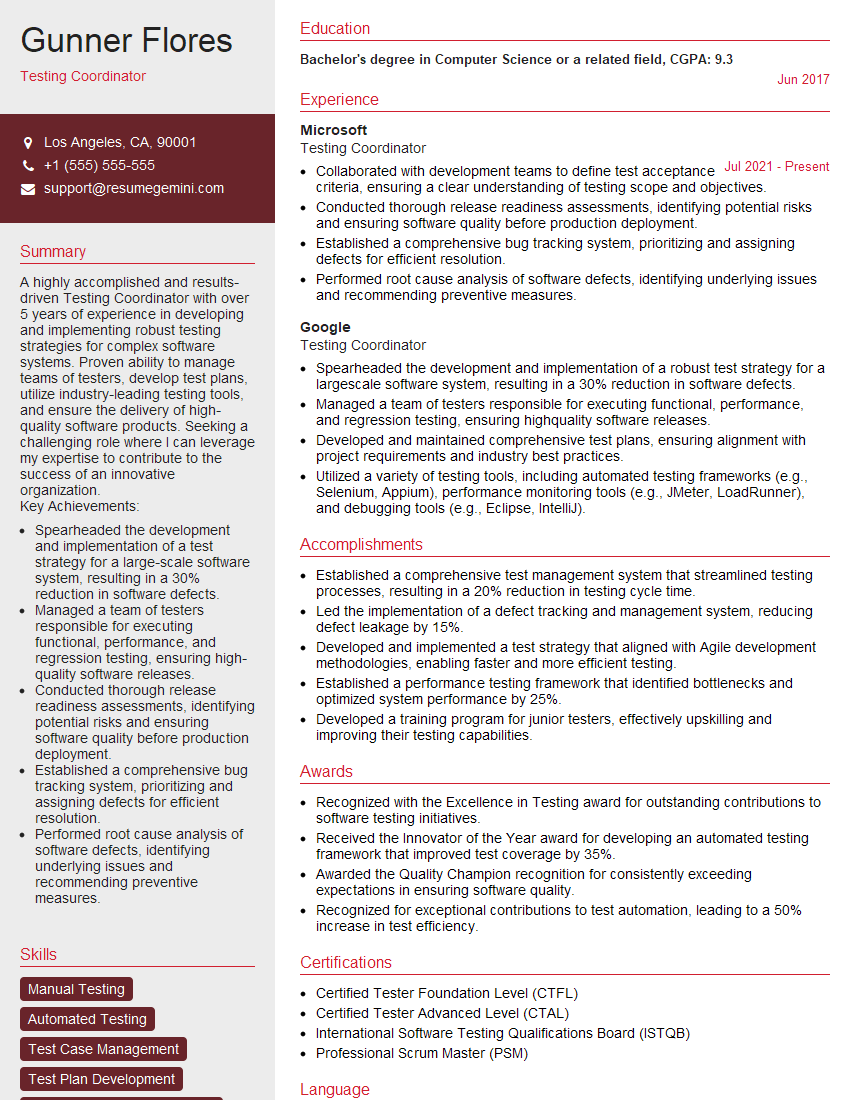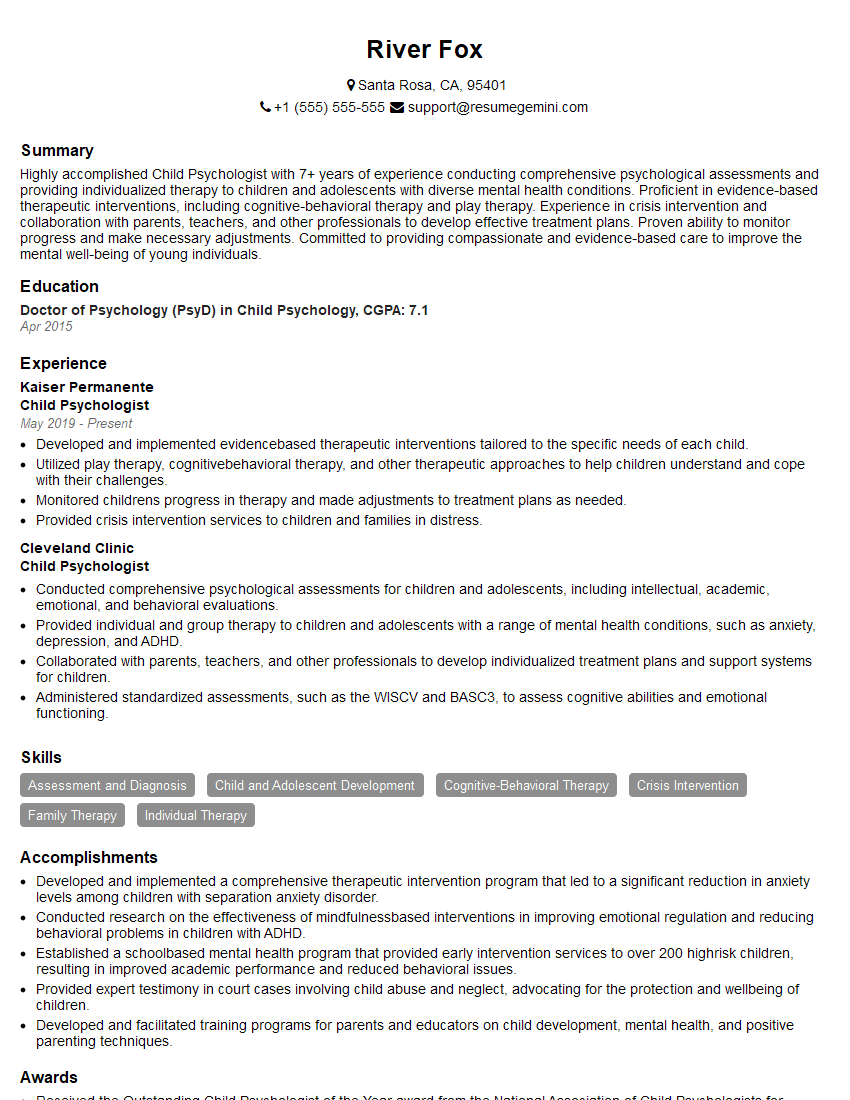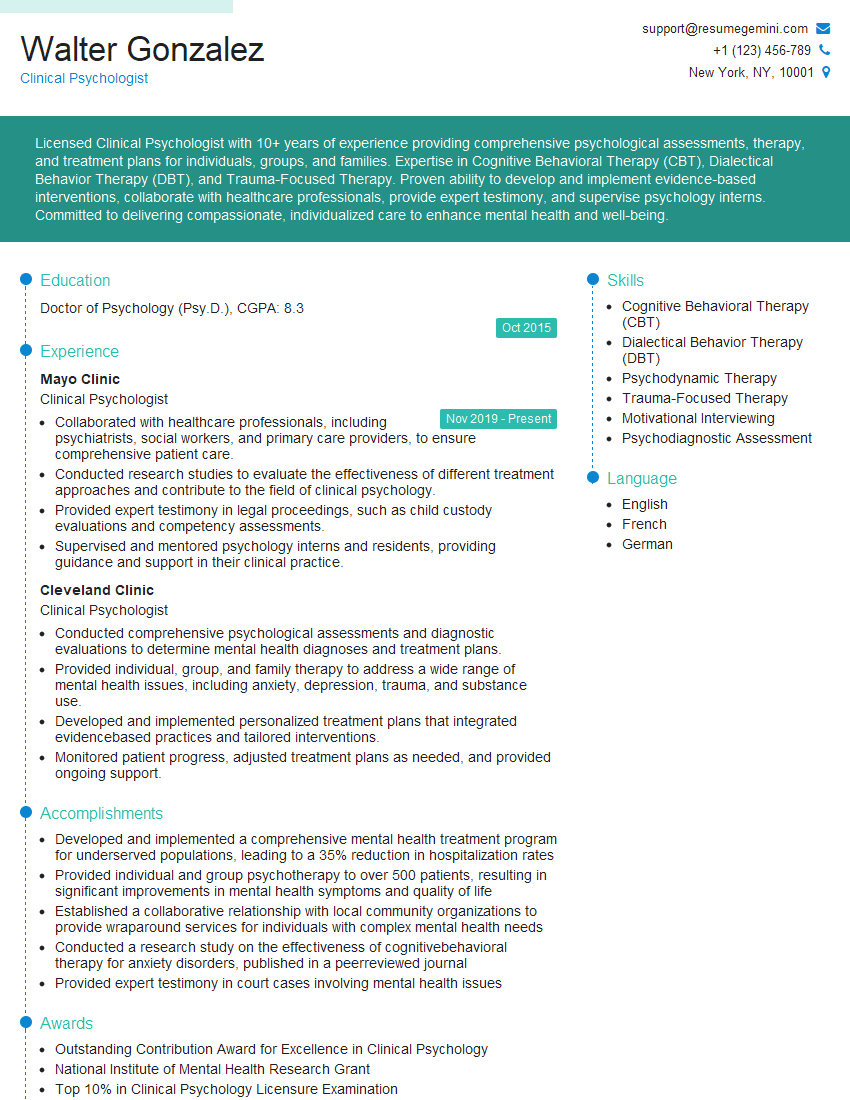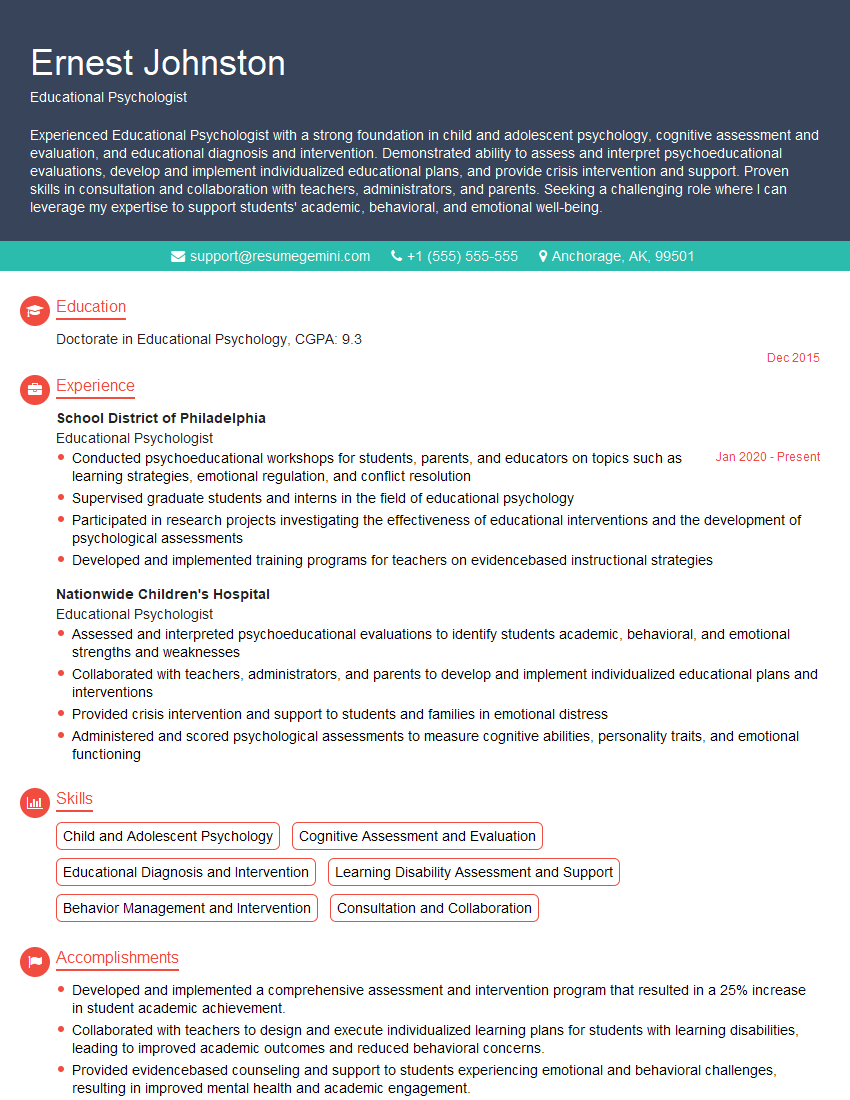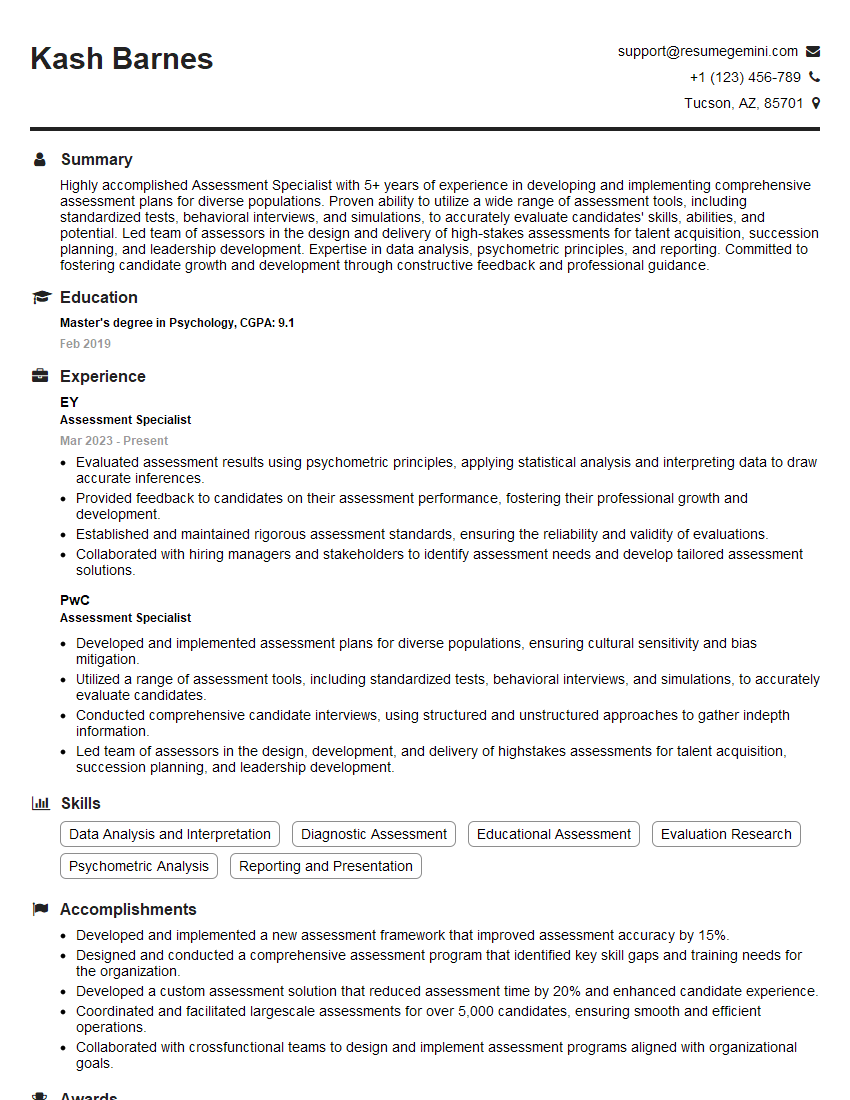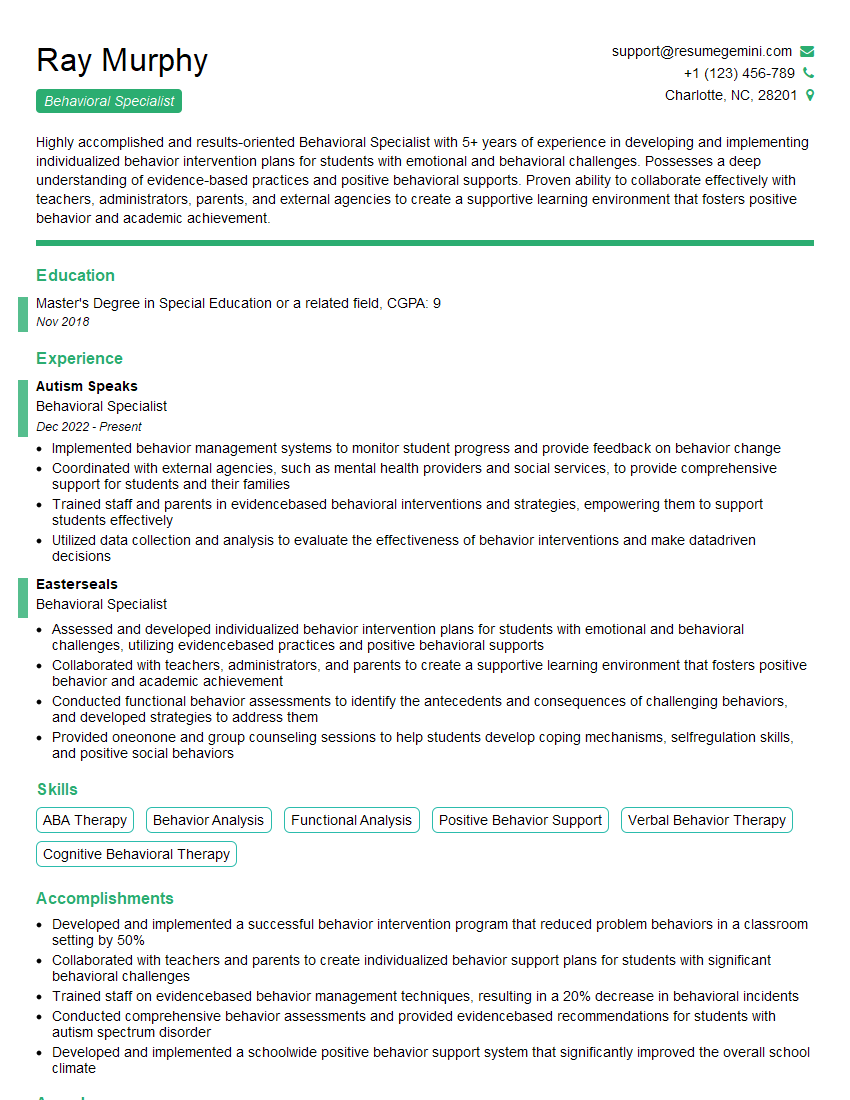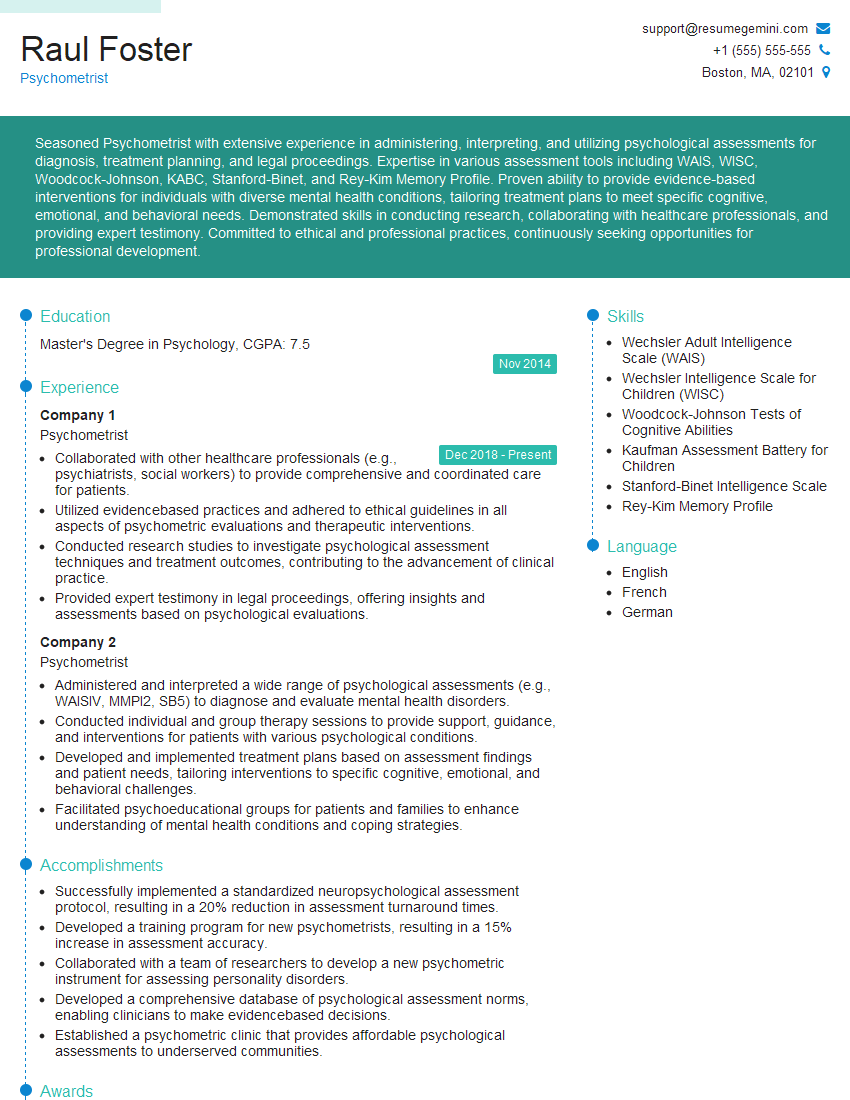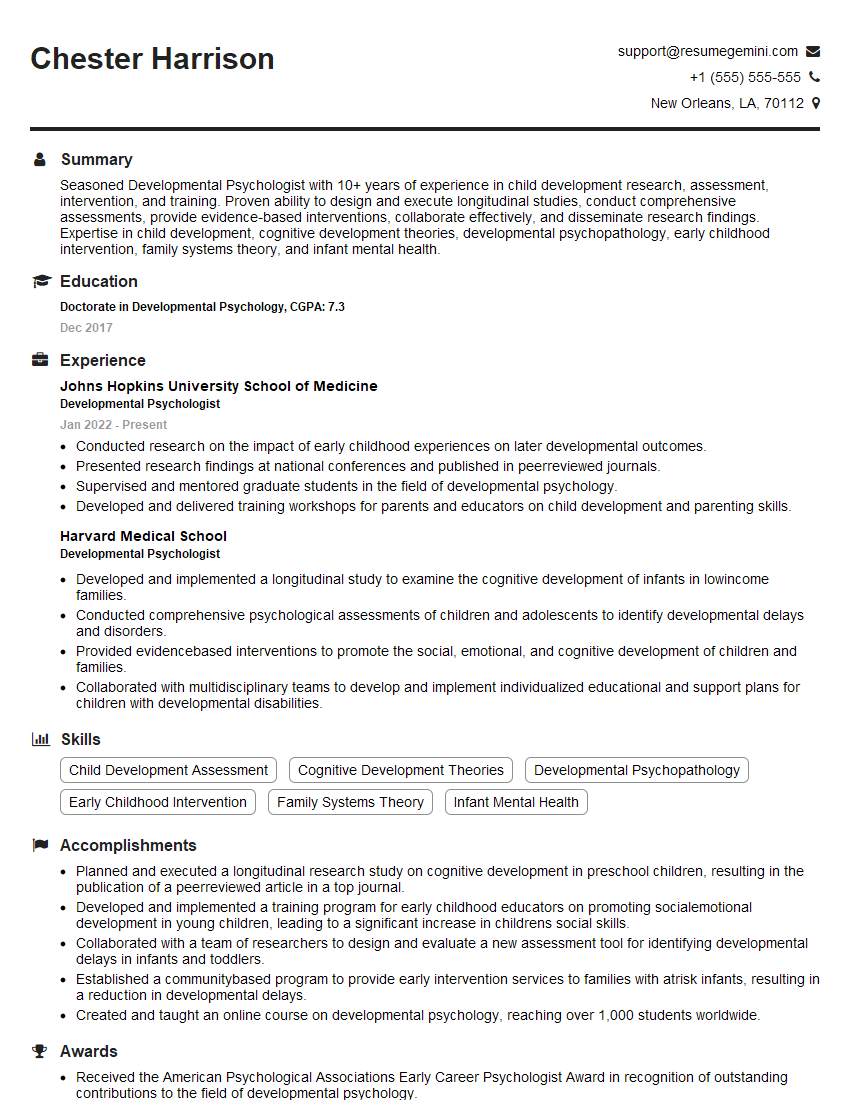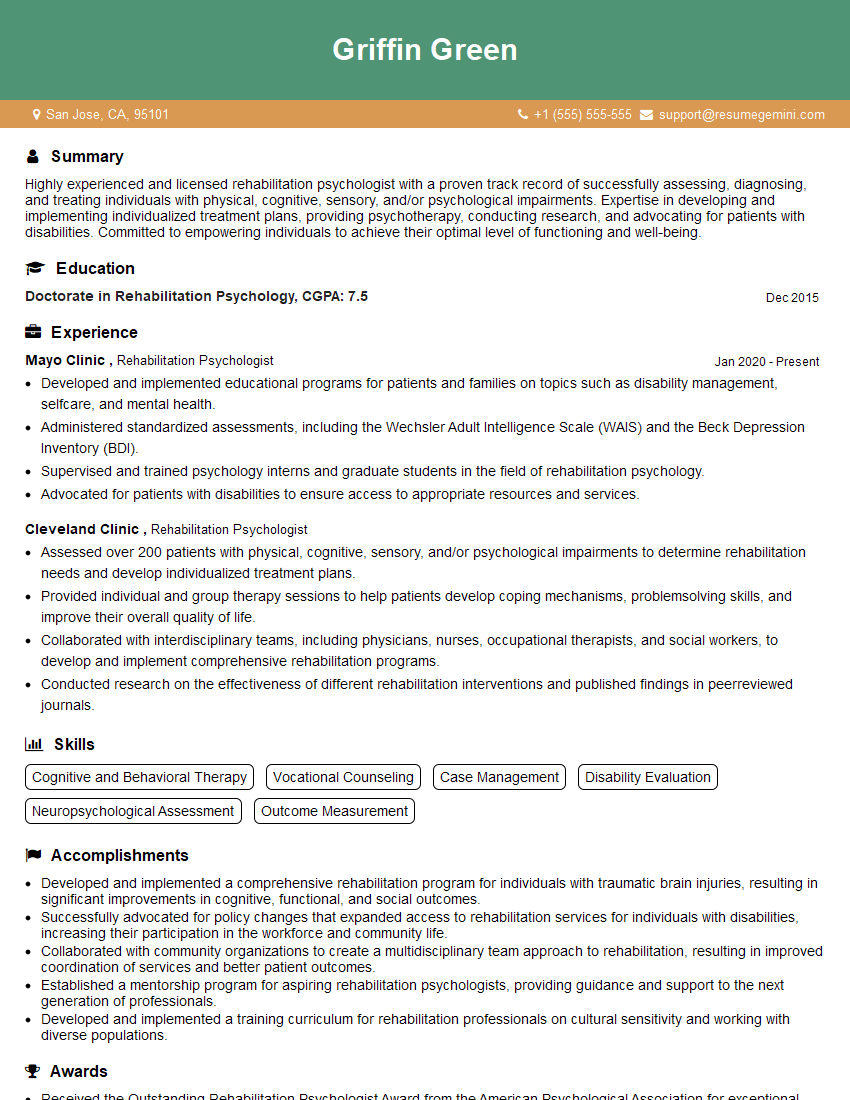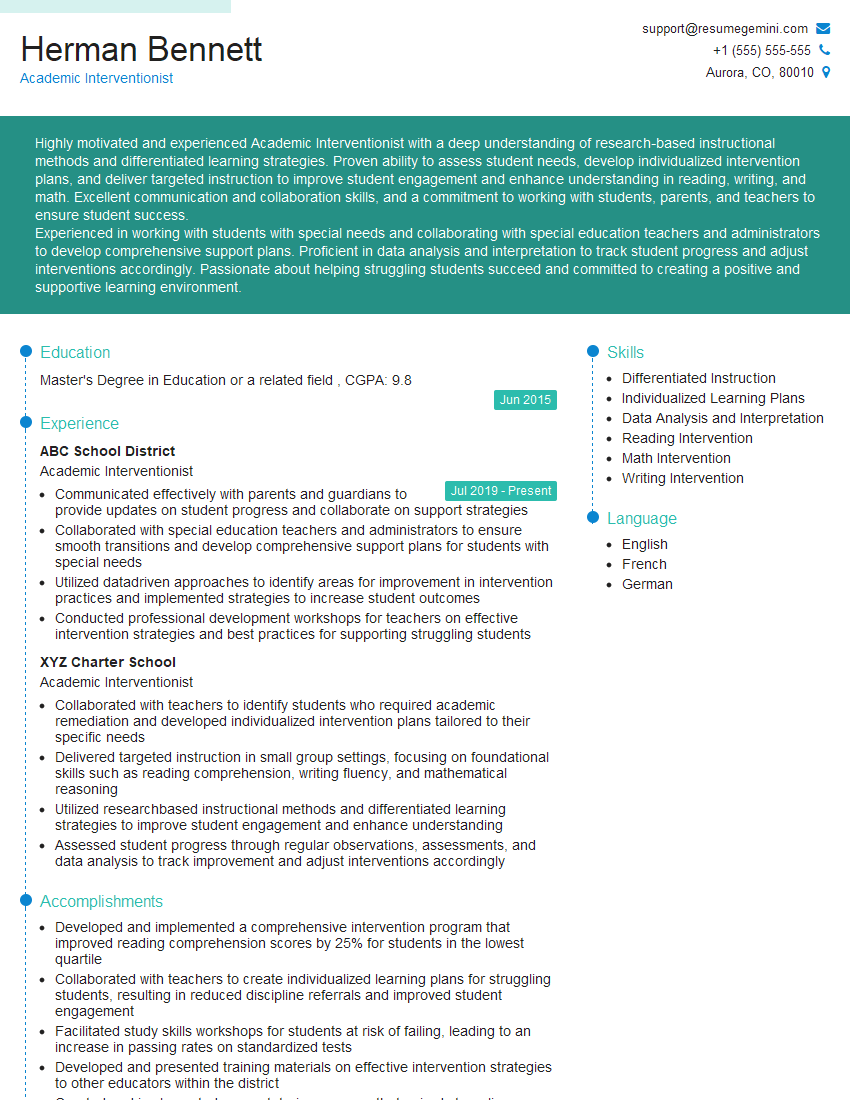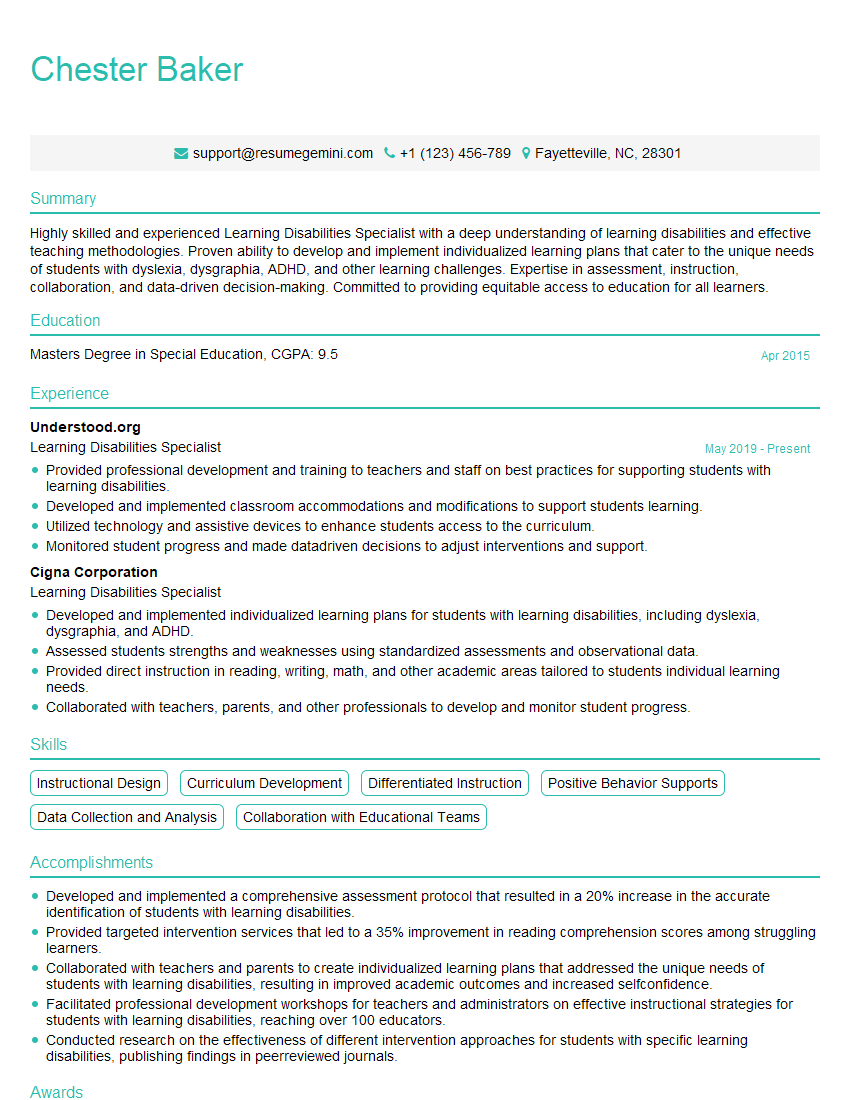The thought of an interview can be nerve-wracking, but the right preparation can make all the difference. Explore this comprehensive guide to Psychoeducational Evaluation interview questions and gain the confidence you need to showcase your abilities and secure the role.
Questions Asked in Psychoeducational Evaluation Interview
Q 1. Describe the process of administering the WISC-V.
Administering the WISC-V, the Wechsler Intelligence Scale for Children – Fifth Edition, is a multi-faceted process requiring careful planning and execution. It begins with establishing rapport with the child, creating a comfortable and focused testing environment. The test itself is administered in a structured manner, following a specific order of subtests designed to assess different cognitive abilities. Each subtest involves clear instructions and demonstration, followed by the child’s responses. I carefully observe the child’s approach to the tasks – their problem-solving strategies, frustration tolerance, and attention span. This qualitative data is as crucial as the quantitative scores. The entire process is meticulously documented, including any observations of behavior or unusual circumstances. For example, if a child is unusually fatigued mid-test, that’s noted. Finally, the raw scores are converted into scaled scores and composite scores using the standardized scoring manual, allowing for a comprehensive profile of the child’s cognitive strengths and weaknesses.
Think of it like a detailed athletic assessment – we’re not just measuring speed, but also agility, strength, and endurance. The WISC-V provides a similar multifaceted profile of cognitive abilities.
Q 2. Explain the differences between a discrepancy model and a response to intervention (RTI) model for identifying learning disabilities.
The discrepancy model and the Response to Intervention (RTI) model are two different approaches to identifying learning disabilities. The discrepancy model relies on comparing a student’s achievement scores (e.g., reading, math) to their intellectual ability (IQ). A significant difference (discrepancy) between these scores suggests a learning disability. For example, a student with an average IQ but significantly below-average reading achievement might be diagnosed under this model. However, this model is criticized for its reliance on identifying students only *after* they have fallen behind significantly, essentially waiting for the problem to become quite noticeable before intervening.
The Response to Intervention (RTI) model is a more proactive approach. It focuses on a student’s response to increasingly intensive levels of academic support. Students receive interventions of varying intensity, and their progress is closely monitored. If a student doesn’t show adequate progress despite receiving high-quality instruction, it may indicate a learning disability. This approach emphasizes early identification and intervention, preventing significant academic setbacks. An example would be a student who struggles with reading despite participating in tiered reading interventions – first, basic classroom support, then small group tutoring, and finally intensive one-on-one support. Lack of progress despite these interventions strongly suggests a learning disability.
In essence, the discrepancy model is retrospective, identifying a problem after it has occurred, while the RTI model is preventative, identifying and addressing potential problems early.
Q 3. What are the key components of a comprehensive psychoeducational evaluation?
A comprehensive psychoeducational evaluation is a multifaceted assessment designed to provide a holistic understanding of a student’s cognitive, academic, social-emotional, and behavioral functioning. Key components include:
- Cognitive Assessment: Using standardized tests like the WISC-V or Stanford-Binet to assess intellectual abilities like verbal comprehension, perceptual reasoning, working memory, and processing speed.
- Academic Achievement Testing: Evaluating academic skills in areas like reading, math, writing, and spelling using standardized achievement tests.
- Behavioral Observations: Direct observation of the student’s behavior in various settings (classroom, home) to assess attention, impulsivity, social skills, and emotional regulation.
- Parent and Teacher Interviews: Gathering information about the student’s developmental history, strengths, weaknesses, and behavior from parents and teachers.
- Review of Educational Records: Examining school records, including grades, report cards, and teacher comments, to get a picture of the student’s academic progress over time.
- Adaptive Behavior Assessment: Measuring a student’s ability to adapt to daily living and social demands. This is particularly important when evaluating for intellectual disability.
- Social-Emotional Assessment: Using questionnaires or interviews to assess the student’s social-emotional skills, emotional well-being, and mental health.
The goal is to not just identify areas of difficulty but to also pinpoint strengths, and, crucially, to understand the interplay between all these factors.
Q 4. How do you interpret the results of a cognitive assessment?
Interpreting cognitive assessment results involves more than just looking at numbers. It requires a nuanced understanding of the student’s performance across different cognitive domains. I begin by examining the overall IQ score, which provides a general measure of cognitive ability. However, this score alone isn’t sufficient; I also analyze the individual subtest scores. A student might have a high overall IQ but struggle in specific areas like processing speed or working memory. This is where the real insights emerge. For instance, a student might show strengths in verbal comprehension but weaknesses in visual-spatial reasoning. This might suggest particular learning strategies would be most effective. Furthermore, I consider the student’s performance in relation to their age and educational level, looking for discrepancies and patterns. The qualitative observations made during the testing are also integrated into the interpretation. For example, observing a student’s frustration levels during tasks adds valuable context to the quantitative data. The entire process aims to generate a comprehensive cognitive profile that helps us understand the student’s strengths, weaknesses, and learning style.
Think of it like a medical diagnosis. An overall blood test might show some abnormalities, but further specialized tests pinpoints the exact problem. Similarly, subtest scores within the cognitive evaluation reveal specific areas needing support.
Q 5. Discuss the ethical considerations in conducting psychoeducational evaluations.
Ethical considerations in psychoeducational evaluations are paramount. They guide every aspect of the process, from obtaining informed consent to reporting results. Key considerations include:
- Confidentiality: Maintaining strict confidentiality of all information obtained during the evaluation, adhering to relevant laws (FERPA, HIPAA) and ethical guidelines.
- Informed Consent: Obtaining informed consent from parents or guardians and, when appropriate, from the student themselves. This involves fully explaining the purpose, procedures, and potential outcomes of the evaluation.
- Cultural Sensitivity: Ensuring assessment materials and procedures are culturally appropriate and don’t disadvantage students from diverse backgrounds. This includes considering language proficiency, cultural values, and potential biases within tests.
- Competence: Only conducting assessments within the scope of one’s professional expertise and training. This includes using appropriate tests and interpreting results accurately.
- Objectivity and Fairness: Striving for objectivity in assessment and interpretation, avoiding biases that may influence the results. We are responsible for unbiased reporting, recognizing our own potential for implicit bias.
- Proper Reporting: Presenting clear, concise, and accurate reports that are readily understandable by parents, educators, and other stakeholders.
Maintaining ethical integrity is not simply following rules; it’s about ensuring the well-being and fairness of the students we serve. It’s about building trust.
Q 6. How do you adapt assessment procedures for students with diverse cultural backgrounds or disabilities?
Adapting assessment procedures for students with diverse cultural backgrounds or disabilities is essential for ensuring fair and accurate evaluations. This necessitates a multi-pronged approach:
- Language Considerations: For students with limited English proficiency, the evaluation should be conducted in their native language, or appropriate accommodations such as bilingual interpreters should be used. This is crucial to avoid misinterpreting results simply due to language barriers.
- Cultural Sensitivity: Test materials and procedures should be culturally appropriate and sensitive to the student’s cultural background, avoiding materials that may be unfamiliar or biased. For example, using culturally relevant examples and avoiding culturally laden language is important.
- Accessibility Modifications: For students with disabilities, accommodations should be implemented as necessary, in accordance with their individualized education program (IEP) or 504 plan. This might include extended time, alternative response formats, or assistive technologies.
- Alternative Assessments: In some cases, alternative assessment methods may be necessary, especially if traditional standardized tests are not appropriate or valid for the student. This could include performance-based assessments or observations.
- Consideration of Biases: Carefully assess standardized tests for potential cultural or other biases before using them. Be aware of test-taker characteristics and test characteristics that might impact a fair assessment.
Adapting assessments is a matter of ensuring that the evaluation truly measures the student’s abilities, not their familiarity with a particular culture or format.
Q 7. What are the common cognitive and academic areas assessed in a psychoeducational evaluation?
Psychoeducational evaluations commonly assess a range of cognitive and academic areas. Cognitive areas often include:
- Intelligence (IQ): General cognitive ability, often assessed with tests like the WISC-V or Stanford-Binet.
- Verbal Comprehension: Understanding and using language.
- Perceptual Reasoning: Visual-spatial skills and problem-solving.
- Working Memory: Holding and manipulating information in mind.
- Processing Speed: Efficiency of cognitive processing.
Academic areas typically assessed include:
- Reading: Phonological awareness, decoding, fluency, comprehension.
- Mathematics: Number sense, calculation, problem-solving.
- Written Expression: Spelling, grammar, composition.
- Oral Expression: Fluency and clarity of spoken language.
The specific areas assessed depend on the student’s individual needs and referral questions. The goal is to create a comprehensive profile that informs educational interventions and support.
Q 8. Explain the importance of parent and teacher input in the evaluation process.
Parent and teacher input is crucial for a comprehensive psychoeducational evaluation because they offer unique perspectives on the child’s strengths, weaknesses, and learning behaviors across different environments. Parents provide insights into the child’s developmental history, home life, and social-emotional functioning, often noticing subtle changes or patterns not observable in a school setting. Teachers, on the other hand, observe the child’s academic performance, classroom behavior, and interactions with peers and instructors. This collaborative approach ensures a holistic understanding, minimizing bias and providing a more accurate picture of the child’s overall functioning.
For example, a teacher might observe a child struggling with reading fluency in class, while the parent might report difficulties with reading comprehension at home. Combining these observations paints a more complete picture than either observation alone, potentially highlighting a specific area of reading deficit or co-occurring challenges.
Q 9. How do you communicate evaluation results to parents and educators?
Communicating evaluation results requires sensitivity and clarity. I utilize a multi-pronged approach. First, I schedule a meeting with the parents, explaining the process and findings in a non-technical manner, using relatable analogies. For example, I might explain working memory deficits as a ‘mental juggling act’ where the child struggles to hold multiple pieces of information in mind at once. Visual aids, such as graphs summarizing test scores, are helpful. I answer questions patiently and encourage dialogue.
Simultaneously, I prepare a written report that summarizes the findings, recommendations, and proposed interventions. This report is also shared with educators, including specific strategies to support the child’s learning in the classroom. I often follow up with a meeting with teachers and school staff to explain the recommendations in detail and answer any questions. This collaborative approach ensures everyone is on the same page and working towards the same goal.
Q 10. Describe your experience with different types of psychological tests and measures.
My experience encompasses a wide range of psychological tests and measures, including intelligence tests (e.g., WISC-V, Stanford-Binet), achievement tests (e.g., WIAT-4, Woodcock-Johnson IV), and measures of attention and executive functioning (e.g., Connors 3, BRIEF). I’m also proficient in using projective measures (e.g., drawing tasks) when appropriate and within ethical guidelines, understanding their limitations. I select specific tests based on the referral question and the individual child’s age and abilities. For instance, I would use different tests for a preschooler versus a high school student, tailoring the assessment to address specific concerns.
Furthermore, I regularly incorporate behavioral observations and parent/teacher interviews to contextualize test data. I believe in utilizing a multi-method approach for a well-rounded evaluation. For instance, a child may score well on an intelligence test but struggle with attention in the classroom – this discrepancy needs to be addressed to offer accurate support.
Q 11. What are some common learning disabilities and their associated characteristics?
Common learning disabilities include dyslexia (difficulty with reading), dysgraphia (difficulty with writing), dyscalculia (difficulty with math), and ADHD (attention-deficit/hyperactivity disorder). These aren’t simply ‘laziness’ or lack of effort but neurological differences affecting learning processes.
- Dyslexia: Characterized by difficulties with phonological awareness, decoding, and reading fluency.
- Dysgraphia: May involve difficulties with handwriting, spelling, and organizing written work. It can manifest as illegible writing, slow writing speed, or difficulty with fine motor skills.
- Dyscalculia: Involves difficulty understanding number concepts, performing calculations, and applying mathematical concepts to real-world problems.
- ADHD: Presents with inattention, impulsivity, and hyperactivity, impacting concentration, organization, and self-regulation, thereby affecting academic performance.
It’s important to note that these learning disabilities can co-occur, and their manifestations can vary significantly from child to child.
Q 12. How do you differentiate between learning disabilities and other factors affecting academic performance?
Differentiating learning disabilities from other factors affecting academic performance requires a thorough assessment. Several factors need to be considered, including intellectual ability, prior learning opportunities, emotional and social factors, and environmental influences.
A learning disability is characterized by a significant discrepancy between a child’s potential (as measured by intelligence tests) and their actual achievement (as measured by achievement tests). Other factors, such as poverty, trauma, inadequate instruction, or lack of motivation, can also impair academic performance. However, these factors typically don’t show a significant discrepancy between ability and achievement when comparing scores from valid and reliable tests of cognitive ability and achievement. A comprehensive psychoeducational evaluation uses multiple methods – including reviewing school records, interviewing parents and teachers, observing the child, and administering psychological tests – to ensure a proper diagnosis is made, ruling out other factors before identifying a specific learning disability.
Q 13. Describe your experience with writing psychoeducational reports.
Writing psychoeducational reports is a critical part of my practice. I strive for clarity, conciseness, and comprehensibility, avoiding jargon whenever possible. Each report includes a detailed background, description of the assessment procedures, summary of findings, interpretations of test results, and specific recommendations for educational interventions. I organize information logically, using headings and subheadings to improve readability.
A crucial aspect is tailoring the report to the audience. The language used in a report for parents is different than the language used for educators. I always ensure the reports are practical, providing actionable steps that parents and educators can implement to support the child’s learning. For example, I might suggest specific strategies for reading intervention, classroom accommodations, or behavioral management techniques. I also include resources and further support information as needed.
Q 14. How do you ensure the validity and reliability of your assessment findings?
Ensuring the validity and reliability of assessment findings is paramount. I utilize standardized, norm-referenced tests that have established psychometric properties. I carefully follow standardized administration and scoring procedures, adhering to the test manuals’ guidelines. I document the entire evaluation process meticulously, including any deviations from standard procedures or observations that might influence the interpretation of results.
Beyond the tests themselves, I use multiple sources of information, such as parent and teacher reports, classroom observations, and review of school records to triangulate the findings. This multi-method approach increases confidence in the overall interpretation. Finally, I am transparent about limitations of the assessment and interpretations, acknowledging the possibility of error inherent in any assessment process.
Q 15. What is your approach to addressing discrepancies between cognitive abilities and academic achievement?
Discrepancies between cognitive abilities and academic achievement are a common finding in psychoeducational evaluations. My approach involves a thorough investigation to understand the underlying reasons. This isn’t just about identifying a gap; it’s about understanding why the gap exists.
Firstly, I utilize a comprehensive battery of assessments, including measures of cognitive abilities (like the WISC-V or Stanford-Binet) and academic achievement tests (like the WIAT-4 or KTEA). This allows me to pinpoint specific areas of strength and weakness. For example, a student might demonstrate high verbal reasoning but struggle with reading fluency. This suggests a potential processing deficit affecting reading skills.
Secondly, I gather information from multiple sources: parents, teachers, the student themselves. Teacher input is crucial—they provide insights into classroom performance, learning strategies, and behavioral observations. Parental perspectives offer valuable context on the student’s history, learning environment at home, and any potential contributing factors. The student’s perspective is also vital, as it helps determine their self-perception and feelings toward school.
Thirdly, I analyze the data to form a hypothesis about the cause of the discrepancy. Is it due to learning disabilities, emotional or behavioral challenges, lack of appropriate instruction, or a combination of factors? This step is crucial for developing effective interventions.
Finally, I clearly communicate my findings and recommendations to the school team and parents, emphasizing collaborative solutions. This might involve suggesting specific academic accommodations, interventions like tutoring or specialized instruction, or further evaluations if needed. For instance, a student with a significant discrepancy might require an evaluation for a specific learning disability like dyslexia.
Career Expert Tips:
- Ace those interviews! Prepare effectively by reviewing the Top 50 Most Common Interview Questions on ResumeGemini.
- Navigate your job search with confidence! Explore a wide range of Career Tips on ResumeGemini. Learn about common challenges and recommendations to overcome them.
- Craft the perfect resume! Master the Art of Resume Writing with ResumeGemini’s guide. Showcase your unique qualifications and achievements effectively.
- Don’t miss out on holiday savings! Build your dream resume with ResumeGemini’s ATS optimized templates.
Q 16. How do you develop individualized education programs (IEPs)?
Developing an Individualized Education Program (IEP) is a collaborative process, and my role is to provide the psychoeducational data that forms the foundation of the plan. I start by carefully reviewing all assessment data, including cognitive, academic, and behavioral information. The goal is to identify the student’s unique learning needs and develop a plan to address those needs effectively.
Next, I participate actively in the IEP meeting, working with the school team, parents, and the student (if appropriate) to establish measurable goals. These goals are specific, attainable, relevant, and time-bound (SMART goals). We might focus on improving reading comprehension by a specific amount within a given timeframe, or enhancing organizational skills through specific strategies.
The IEP also outlines the specific services and accommodations the student will receive. This might include specialized instruction, assistive technology, modifications to classroom assignments, or support from specialized staff like a resource teacher. The services must be based on the identified needs and measurable goals.
Regular monitoring of the IEP’s progress is essential. I contribute by reassessing the student’s performance at intervals outlined in the IEP to evaluate if the interventions are effective. If progress is not as expected, the IEP is reviewed and revised collaboratively to ensure the student receives the most appropriate support.
An example: A student with a diagnosed learning disability in reading might have an IEP goal of increasing their reading fluency by 20 words per minute in one semester. The IEP would then outline specific interventions, such as targeted reading instruction using a specific program and assistive technology to aid comprehension.
Q 17. What are your strategies for working collaboratively with school teams?
Collaboration is at the heart of effective psychoeducational practice. My approach emphasizes clear communication, shared decision-making, and mutual respect for everyone’s expertise. I consider myself part of a team, not an isolated evaluator.
I start by establishing strong relationships with school staff, including teachers, administrators, and special education staff. This involves attending meetings promptly, responding promptly to communications, and actively listening to their perspectives on the student’s challenges and strengths. Regular communication and feedback are essential throughout the process.
I provide clear and concise reports that summarize my findings in a user-friendly format. The language is readily understood by non-professionals, and I offer explanations to clarify any technical terms. I make sure to highlight the implications of my findings for instruction and support.
I value the expertise of teachers in understanding the classroom environment and learning context. I incorporate their observations into my interpretations of assessment data to form a more comprehensive picture. For example, a teacher’s observation that a student struggles with organization could support my assessment findings of executive functioning difficulties.
I actively participate in IEP meetings and other collaborative settings. I don’t just present my findings; I actively contribute to the development of intervention strategies and participate in the ongoing monitoring of the student’s progress.
Q 18. How do you manage challenging behaviors during assessment?
Managing challenging behaviors during assessment is a crucial aspect of ensuring accurate and reliable results. My strategy centers on creating a safe, comfortable, and structured environment that minimizes distractions and promotes cooperation. I use strategies based on principles of Applied Behavior Analysis.
Before the assessment, I make sure to get as much information about the student’s typical behavior as possible from parents, teachers, and prior records. This helps anticipate potential challenges. Building rapport is also key; I start by engaging with the student in a non-threatening, friendly way, letting them know the purpose of the assessment in age-appropriate terms.
During the assessment, I use a flexible approach. If a student becomes distressed, I might take short breaks, adjust the task demands, or use positive reinforcement to encourage continued participation. I might incorporate preferred activities into the assessment. If a student is highly distractible, I modify the testing environment to minimize distractions.
If challenging behaviors persist and significantly impact the assessment, I might modify the testing procedure or even postpone the evaluation until conditions are more conducive. In such situations, I collaborate closely with the student’s school to determine a suitable time and place for retesting. Documentation of these modifications is crucial for maintaining the validity of the assessment.
For example, if a student demonstrates significant anxiety during testing, I might incorporate short breaks or reduce the length of testing sessions. If a student exhibits disruptive behaviors, I might attempt to redirect their attention or work with them to create a behavior management plan.
Q 19. What is your experience with specific assessment instruments, such as the Woodcock-Johnson or KTEA?
I have extensive experience using the Woodcock-Johnson IV (WJ IV) and the KTEA-3. Both are comprehensive achievement tests providing valuable insights into various academic domains.
The Woodcock-Johnson IV is a powerhouse. Its breadth of cognitive and achievement tests allows for a detailed assessment of a student’s cognitive abilities, including processing speed, memory, and visual-spatial skills, and its detailed subtests can be incredibly informative. I use its various clusters to pinpoint strengths and weaknesses within those larger areas. For example, I can compare performance on the Verbal Comprehension cluster to the Visual-Spatial cluster to identify potential cognitive profiles indicative of specific learning disabilities.
The KTEA-3 is particularly useful for identifying specific areas of academic difficulty in reading, math, and written language. Its comprehensive coverage of foundational skills and higher-order thinking allows for a nuanced understanding of a student’s academic profile. For example, using the KTEA’s reading subtests helps me differentiate between difficulties in phonological awareness, decoding, and reading comprehension.
Both the WJ IV and KTEA-3 provide valuable information for diagnosing learning disabilities, identifying areas needing academic intervention, and creating effective IEPs. It’s crucial to remember that no single test is definitive. I always interpret results in the context of other assessment data, observations, and information from parents and teachers.
Q 20. Describe your experience using technology in psychoeducational assessments.
Technology plays an increasingly vital role in psychoeducational assessments, offering efficiency, enhanced data analysis, and accessibility. I’m proficient in using various technology-based assessment tools and platforms.
Many tests now offer computerized versions, offering benefits such as automated scoring and immediate feedback. This saves time and reduces the possibility of human error in scoring. Furthermore, some platforms offer adaptive testing, which adjusts the difficulty of questions based on the student’s responses, increasing efficiency and providing a more accurate assessment of their abilities.
I’m comfortable using various software programs for data analysis and report generation. These tools allow for more efficient report writing and data visualization, enabling me to communicate my findings more clearly and effectively. For example, I can create graphs and charts illustrating a student’s performance across different academic areas, making it easier for parents and teachers to understand complex data.
Furthermore, technology can improve accessibility. For example, using screen readers or adaptive software can make assessments more accessible to students with visual impairments or other disabilities. Online platforms can also streamline the assessment process, reducing the time spent on logistical tasks.
However, it’s also important to address the ethical considerations of using technology in assessment, such as ensuring test security and ensuring equitable access to technology for all students.
Q 21. How do you address the impact of trauma on a student’s academic performance?
The impact of trauma on academic performance is significant and often overlooked. My approach involves recognizing the potential influence of trauma on cognitive functioning, emotional regulation, and behavior, which then influences a student’s learning experience.
First, I gather information about the student’s history using various methods, including questionnaires, interviews with parents and the student, and reviewing relevant records. This helps identify potential trauma exposure. I approach this with sensitivity and cultural humility, being mindful that trauma can manifest differently depending on the individual’s background.
Second, I use assessment tools to evaluate the student’s cognitive and emotional functioning, including assessing for symptoms of PTSD, anxiety, or depression. The assessment would also look at executive functioning skills that are frequently impacted by trauma, such as attention, impulse control, and organization.
Third, I work closely with the school team, parents, and other relevant professionals (e.g., therapists) to develop a comprehensive intervention plan that addresses both the academic and emotional needs of the student. This might involve creating a trauma-informed classroom environment, providing access to mental health services, and implementing accommodations or modifications to reduce academic stress.
Fourth, I continually monitor the student’s progress, and reassess their needs and adjust the intervention plan accordingly. Collaboration with the entire team is crucial to provide the student with ongoing support in an understanding environment. The goal is to create a supportive learning environment that fosters healing and allows the student to reach their full academic potential.
For example, a student who has experienced significant trauma might benefit from having breaks during the school day, a calming corner in the classroom, and extra support with organization and time management. Understanding their history and needs empowers us to create strategies that are more effective than a general approach.
Q 22. How do you ensure cultural sensitivity and bias mitigation in your assessments?
Cultural sensitivity and bias mitigation are paramount in psychoeducational evaluations. We must recognize that standardized tests, while valuable, are developed within specific cultural contexts and may not accurately reflect the abilities of individuals from diverse backgrounds. My approach involves several key strategies:
- Utilizing culturally appropriate assessment tools: I select assessments that have been validated for use with the specific cultural group being evaluated, or that minimize cultural bias as much as possible. This might involve using interpreters, adapting instructions, or selecting alternative assessments altogether.
- Considering the individual’s life experiences: I take the time to understand the student’s background, including their language proficiency, socioeconomic status, and cultural values. This information provides context for interpreting test results and avoids misinterpretations based on cultural differences. For example, a student from a culture that emphasizes collectivism might perform differently on tasks that require individual initiative compared to a student from an individualistic culture.
- Employing a multifaceted approach: I don’t rely solely on standardized tests. I integrate observations, interviews with parents and teachers, and informal assessments to gain a comprehensive understanding of the student’s strengths and challenges. This helps to mitigate the limitations of any single assessment instrument.
- Ongoing professional development: I regularly engage in professional development opportunities focusing on cultural competence and bias awareness to continually refine my skills and knowledge in this crucial area.
For example, I recently worked with a student whose first language wasn’t English. While the standardized test showed some cognitive delays, my observations and conversations with the student and family revealed exceptional storytelling skills. This prompted me to incorporate alternative assessment methods, revealing their true cognitive potential.
Q 23. What is your understanding of different theoretical frameworks related to learning and development?
My understanding of learning and development is informed by several theoretical frameworks, each offering valuable insights into different aspects of the learning process. Some key frameworks I utilize include:
- Cognitive Developmental Theory (Piaget): This framework highlights the stages of cognitive development, emphasizing the importance of understanding a student’s cognitive maturity when designing interventions. For example, a student in the concrete operational stage might struggle with abstract concepts, requiring a more hands-on approach.
- Social Cognitive Theory (Bandura): This framework emphasizes the role of observation, modeling, and self-efficacy in learning. Understanding a student’s belief in their ability to succeed is crucial for creating effective learning plans. I frequently incorporate strategies that promote self-efficacy, such as goal setting and providing positive feedback.
- Information Processing Theory: This approach focuses on how students receive, process, store, and retrieve information. It helps me understand potential challenges in areas such as attention, memory, and processing speed, guiding the selection of appropriate assessment and intervention strategies.
- Neuropsychological Frameworks: These help understand the impact of neurological factors on cognitive function and learning. A solid understanding of neuropsychology allows for an informed interpretation of assessment data, and differentiation of difficulties arising from neurodevelopmental conditions, such as learning disabilities.
Integrating these frameworks provides a holistic perspective on learning and development, allowing for a more comprehensive and effective psychoeducational evaluation.
Q 24. Describe your experience with students who have ADHD or other attentional difficulties.
I have extensive experience working with students who have ADHD and other attentional difficulties. These students often present with diverse challenges, requiring individualized assessment and intervention strategies. My approach focuses on a thorough understanding of the student’s specific presentation of ADHD. This includes:
- Comprehensive assessment: Using a combination of standardized tests (e.g., WISC-V, Conner’s Rating Scales), behavioral observations, and parent/teacher interviews to obtain a complete picture of their attention, executive function, and academic performance.
- Strengths-based approach: Identifying the student’s strengths and talents to build upon them while addressing weaknesses. Many students with ADHD possess creativity, energy, and unique problem-solving skills that can be leveraged.
- Tailored interventions: Developing individualized strategies to improve focus and self-regulation. This could involve classroom accommodations, behavioral interventions, and/or medication management in coordination with a physician.
- Collaboration with parents and educators: Working closely with parents and teachers to implement consistent strategies across all environments and enhance understanding.
One student I worked with displayed significant inattention and impulsivity in a traditional classroom setting. However, through careful observation, I noticed her exceptional artistic talent. By providing her with opportunities for creative expression, I saw a significant improvement in her focus and engagement. This illustrates the importance of understanding the individual’s unique needs and adapting assessment and intervention accordingly.
Q 25. What are your professional development goals related to psychoeducational evaluation?
My professional development goals center on staying at the forefront of best practices in psychoeducational evaluation. Specifically, I aim to:
- Expand my knowledge of neuropsychological assessment: Deepening my understanding of the neurological underpinnings of learning and cognitive abilities to provide even more accurate and nuanced evaluations.
- Enhance my skills in culturally responsive assessment: Continuously refining my ability to provide equitable and culturally sensitive evaluations for students from diverse backgrounds.
- Become proficient in utilizing new technologies in assessment: Exploring and integrating innovative assessment tools and technologies to enhance the efficiency and effectiveness of my evaluations.
- Strengthen my collaboration skills: Improving my ability to work effectively with multidisciplinary teams, including educators, therapists, and medical professionals, to create comprehensive and impactful interventions.
These goals are not just about accumulating knowledge but about transforming that knowledge into improved outcomes for the students I serve.
Q 26. How do you maintain confidentiality and adhere to ethical guidelines in your practice?
Confidentiality and ethical practice are non-negotiable in my work. I adhere strictly to all relevant laws and ethical guidelines, including those established by professional organizations such as the American Psychological Association (APA). My commitment to confidentiality includes:
- Secure storage of assessment data: Maintaining the strictest security measures for all evaluation documents, both physical and electronic.
- Limited access to information: Sharing assessment findings only with authorized individuals, such as parents, educators, and relevant healthcare professionals, with the student’s informed consent (where appropriate).
- Maintaining client anonymity: Using pseudonyms or identifiers when discussing cases publicly or in professional settings.
- Compliance with legal mandates: Adhering to all mandatory reporting requirements regarding child abuse or neglect.
- Informed consent: Obtaining informed consent from parents/guardians and students (when appropriate) before conducting any evaluation or sharing results.
Ethical dilemmas are approached systematically, with careful consideration of all relevant ethical codes and legal implications. I prioritize the best interests of the students I evaluate in all my professional interactions.
Q 27. Describe a situation where you had to adapt your assessment approach due to unforeseen circumstances.
During a recent evaluation, a student experienced a significant emotional distress during the testing session, preventing completion of the standardized measures. Instead of forcing the student to continue, I adapted my approach. I paused the testing, validated their feelings, and utilized alternative methods to assess their cognitive abilities. This included informal observations of their interactions, creative tasks (drawing, storytelling), and engaging in conversations to gather information about their strengths and challenges. Following this, I scheduled a subsequent session, ensuring a calmer and more supportive environment. I explained the adjustments made in my report, emphasizing the limitations of the data while offering a holistic perspective based on the information I collected. This demonstrated flexibility and responsiveness to the student’s needs, ultimately ensuring a comprehensive, albeit non-standard, evaluation.
Key Topics to Learn for Psychoeducational Evaluation Interview
- Assessment Instruments: Understanding the strengths and limitations of various standardized tests (e.g., WISC-V, KTEA, Woodcock-Johnson), including administration, scoring, and interpretation.
- Interpreting Test Data: Developing skills in analyzing test results within the context of a child’s developmental history, academic performance, and social-emotional functioning. This includes understanding standard scores, percentiles, and confidence intervals.
- Diagnostic Considerations: Familiarity with diagnostic criteria for learning disabilities, ADHD, intellectual disabilities, and other relevant conditions. This involves applying theoretical frameworks to interpret assessment data and formulate diagnoses.
- Report Writing: Mastering the art of writing clear, concise, and comprehensive psychoeducational reports that effectively communicate assessment findings and recommendations to parents, educators, and other professionals.
- Ethical Considerations: Understanding ethical principles related to confidentiality, informed consent, cultural sensitivity, and appropriate test administration practices.
- Intervention Strategies: Familiarity with evidence-based interventions for addressing learning difficulties and related challenges, and being able to suggest appropriate interventions based on assessment results.
- Collaboration & Communication: Demonstrating effective communication skills and the ability to collaborate effectively with parents, teachers, and other professionals involved in a student’s education.
- Legal & Regulatory Aspects: Basic understanding of relevant laws and regulations concerning special education services and the provision of psychoeducational evaluations.
Next Steps
Mastering psychoeducational evaluation is crucial for career advancement in education, psychology, and related fields. It opens doors to fulfilling roles where you can make a significant difference in the lives of children and families. To maximize your job prospects, creating an ATS-friendly resume is essential. ResumeGemini is a trusted resource to help you build a professional resume that highlights your skills and experience effectively. Examples of resumes tailored to psychoeducational evaluation positions are available through ResumeGemini to guide you in building your own compelling application materials.
Explore more articles
Users Rating of Our Blogs
Share Your Experience
We value your feedback! Please rate our content and share your thoughts (optional).
What Readers Say About Our Blog
This was kind of a unique content I found around the specialized skills. Very helpful questions and good detailed answers.
Very Helpful blog, thank you Interviewgemini team.

